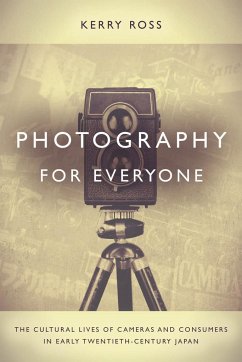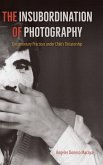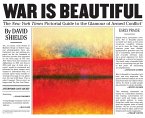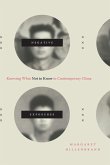Kerry Ross
Photography for Everyone
The Cultural Lives of Cameras and Consumers in Early Twentieth-Century Japan
Kerry Ross
Photography for Everyone
The Cultural Lives of Cameras and Consumers in Early Twentieth-Century Japan
- Gebundenes Buch
- Merkliste
- Auf die Merkliste
- Bewerten Bewerten
- Teilen
- Produkt teilen
- Produkterinnerung
- Produkterinnerung
Kerry Ross is an Assistant Professor in the Department of History at DePaul University.
Andere Kunden interessierten sich auch für
![The Insubordination of Photography The Insubordination of Photography]() Ángeles Donoso MacayaThe Insubordination of Photography92,99 €
Ángeles Donoso MacayaThe Insubordination of Photography92,99 €![Liminalities of Gender and Sexuality in Nineteenth-Century Iranian Photography Liminalities of Gender and Sexuality in Nineteenth-Century Iranian Photography]() Staci Gem ScheiwillerLiminalities of Gender and Sexuality in Nineteenth-Century Iranian Photography229,99 €
Staci Gem ScheiwillerLiminalities of Gender and Sexuality in Nineteenth-Century Iranian Photography229,99 €![Disappearing Witness Disappearing Witness]() Gretchen GarnerDisappearing Witness58,99 €
Gretchen GarnerDisappearing Witness58,99 €![Picturing Dogs, Seeing Ourselves Picturing Dogs, Seeing Ourselves]() Ann-Janine MoreyPicturing Dogs, Seeing Ourselves37,99 €
Ann-Janine MoreyPicturing Dogs, Seeing Ourselves37,99 €![The Pacific War The Pacific War]() John CostelloThe Pacific War23,99 €
John CostelloThe Pacific War23,99 €![War Is Beautiful War Is Beautiful]() David ShieldsWar Is Beautiful36,99 €
David ShieldsWar Is Beautiful36,99 €![Negative Exposures Negative Exposures]() Margaret HillenbrandNegative Exposures157,99 €
Margaret HillenbrandNegative Exposures157,99 €-
-
-
Kerry Ross is an Assistant Professor in the Department of History at DePaul University.
Hinweis: Dieser Artikel kann nur an eine deutsche Lieferadresse ausgeliefert werden.
Hinweis: Dieser Artikel kann nur an eine deutsche Lieferadresse ausgeliefert werden.
Produktdetails
- Produktdetails
- Verlag: Stanford University Press
- Seitenzahl: 256
- Erscheinungstermin: 24. Juni 2015
- Englisch
- Abmessung: 231mm x 155mm x 18mm
- Gewicht: 454g
- ISBN-13: 9780804794237
- ISBN-10: 0804794235
- Artikelnr.: 41751623
- Herstellerkennzeichnung
- Libri GmbH
- Europaallee 1
- 36244 Bad Hersfeld
- gpsr@libri.de
- Verlag: Stanford University Press
- Seitenzahl: 256
- Erscheinungstermin: 24. Juni 2015
- Englisch
- Abmessung: 231mm x 155mm x 18mm
- Gewicht: 454g
- ISBN-13: 9780804794237
- ISBN-10: 0804794235
- Artikelnr.: 41751623
- Herstellerkennzeichnung
- Libri GmbH
- Europaallee 1
- 36244 Bad Hersfeld
- gpsr@libri.de
Kerry Ross is an Assistant Professor in the Department of History at DePaul University.
Contents and Abstracts
Introduction: Introduction
chapter abstract
The Introduction familiarizes readers with the topics of the early
twentieth-century photography market and amateur practices in Japan by
situating the project historiographically in relation to three fields of
scholarship: the history of photography; the history of retailing,
consumption, and gender; and the history of middle-class culture.
1A Retail Revolution: Male Shoppers and the Creation of the Modern Shop
chapter abstract
Chapter 1 argues that the camera industry, alongside department stores, was
at the forefront of a retail revolution focusing on male shoppers from the
turn of the twentieth century. It offers a cultural history of retail
practices in urban Japan, focusing on Konishi Roku (today's Konica
Minolta), Japan's leading camera producer, whose headquarters and main shop
were located in Nihonbashi, Tokyo.
2Chapter 2. Photography for Everyone: Women, Hobbyists, and Marketing
Photography
chapter abstract
Chapter 2 explores the camera market's segmentation into two distinctly
gendered consumer markets, the casual photography market and the amateur
photography market, and the innovative ways that the camera industry
marketed its products to these very different consumer groups. In the drive
for profit, the camera industry cultivated a casual photography market that
promised photography was for everyone. In reality, sales in this market
were based on an assumed female consumer, one who lacked photographic
knowledge and simply consumed film by taking pictures willy-nilly. However,
in fostering the amateur or hobby market, the camera industry focused on
the male consumer, addressed as a knowledgeable man, or at least one
seeking to become a knowledgeable man, invested in honing his skills in the
art and technology of photography.
3Instructions for Life: How-to Literature and Hobby Photography
chapter abstract
Chapter 3 investigates the role of how-to books in popularizing
photography, both in terms of their explicit, stated purpose to teach
photographers how to take and make photographs and the ways in which they
suggested to readers the appropriate place of photography in their leisure
time and in their homes.
4Democratizing Leisure: Camera Clubs and the Popularization of Photography
chapter abstract
Chapter 4 explores the role of camera clubs in the spread of photography,
in particular, the ways in which participation offered members the
opportunity to socialize with their peers and to congregate around a shared
leisure-time activity. They also served as a venue to rehearse the
democratic principles of participatory governance, such as voting for
officers, opportunities denied to most in the public realm of politics.
5Making Middlebrow Photography: The Aesthetics and Craft of Amateur
Photography
chapter abstract
Chapter 5 considers the actual pictures that amateurs took with an aim to
understand popular aesthetics of the time. Amateur photography, not only as
final product but also as a total process, provided hobbyists with an
aesthetic language that matched their middle-class ideals: an active place
in the world of consumerism befitting their newfound incomes and an
absorbing activity that placed value on craftsmanship.
Epilogue: Epilogue
chapter abstract
The Epilogue offers a concise account of the wartime restrictions on
consumption and photographic practice and the rapid rebuilding of the
photography industry immediately after the war.
Introduction: Introduction
chapter abstract
The Introduction familiarizes readers with the topics of the early
twentieth-century photography market and amateur practices in Japan by
situating the project historiographically in relation to three fields of
scholarship: the history of photography; the history of retailing,
consumption, and gender; and the history of middle-class culture.
1A Retail Revolution: Male Shoppers and the Creation of the Modern Shop
chapter abstract
Chapter 1 argues that the camera industry, alongside department stores, was
at the forefront of a retail revolution focusing on male shoppers from the
turn of the twentieth century. It offers a cultural history of retail
practices in urban Japan, focusing on Konishi Roku (today's Konica
Minolta), Japan's leading camera producer, whose headquarters and main shop
were located in Nihonbashi, Tokyo.
2Chapter 2. Photography for Everyone: Women, Hobbyists, and Marketing
Photography
chapter abstract
Chapter 2 explores the camera market's segmentation into two distinctly
gendered consumer markets, the casual photography market and the amateur
photography market, and the innovative ways that the camera industry
marketed its products to these very different consumer groups. In the drive
for profit, the camera industry cultivated a casual photography market that
promised photography was for everyone. In reality, sales in this market
were based on an assumed female consumer, one who lacked photographic
knowledge and simply consumed film by taking pictures willy-nilly. However,
in fostering the amateur or hobby market, the camera industry focused on
the male consumer, addressed as a knowledgeable man, or at least one
seeking to become a knowledgeable man, invested in honing his skills in the
art and technology of photography.
3Instructions for Life: How-to Literature and Hobby Photography
chapter abstract
Chapter 3 investigates the role of how-to books in popularizing
photography, both in terms of their explicit, stated purpose to teach
photographers how to take and make photographs and the ways in which they
suggested to readers the appropriate place of photography in their leisure
time and in their homes.
4Democratizing Leisure: Camera Clubs and the Popularization of Photography
chapter abstract
Chapter 4 explores the role of camera clubs in the spread of photography,
in particular, the ways in which participation offered members the
opportunity to socialize with their peers and to congregate around a shared
leisure-time activity. They also served as a venue to rehearse the
democratic principles of participatory governance, such as voting for
officers, opportunities denied to most in the public realm of politics.
5Making Middlebrow Photography: The Aesthetics and Craft of Amateur
Photography
chapter abstract
Chapter 5 considers the actual pictures that amateurs took with an aim to
understand popular aesthetics of the time. Amateur photography, not only as
final product but also as a total process, provided hobbyists with an
aesthetic language that matched their middle-class ideals: an active place
in the world of consumerism befitting their newfound incomes and an
absorbing activity that placed value on craftsmanship.
Epilogue: Epilogue
chapter abstract
The Epilogue offers a concise account of the wartime restrictions on
consumption and photographic practice and the rapid rebuilding of the
photography industry immediately after the war.
Contents and Abstracts
Introduction: Introduction
chapter abstract
The Introduction familiarizes readers with the topics of the early
twentieth-century photography market and amateur practices in Japan by
situating the project historiographically in relation to three fields of
scholarship: the history of photography; the history of retailing,
consumption, and gender; and the history of middle-class culture.
1A Retail Revolution: Male Shoppers and the Creation of the Modern Shop
chapter abstract
Chapter 1 argues that the camera industry, alongside department stores, was
at the forefront of a retail revolution focusing on male shoppers from the
turn of the twentieth century. It offers a cultural history of retail
practices in urban Japan, focusing on Konishi Roku (today's Konica
Minolta), Japan's leading camera producer, whose headquarters and main shop
were located in Nihonbashi, Tokyo.
2Chapter 2. Photography for Everyone: Women, Hobbyists, and Marketing
Photography
chapter abstract
Chapter 2 explores the camera market's segmentation into two distinctly
gendered consumer markets, the casual photography market and the amateur
photography market, and the innovative ways that the camera industry
marketed its products to these very different consumer groups. In the drive
for profit, the camera industry cultivated a casual photography market that
promised photography was for everyone. In reality, sales in this market
were based on an assumed female consumer, one who lacked photographic
knowledge and simply consumed film by taking pictures willy-nilly. However,
in fostering the amateur or hobby market, the camera industry focused on
the male consumer, addressed as a knowledgeable man, or at least one
seeking to become a knowledgeable man, invested in honing his skills in the
art and technology of photography.
3Instructions for Life: How-to Literature and Hobby Photography
chapter abstract
Chapter 3 investigates the role of how-to books in popularizing
photography, both in terms of their explicit, stated purpose to teach
photographers how to take and make photographs and the ways in which they
suggested to readers the appropriate place of photography in their leisure
time and in their homes.
4Democratizing Leisure: Camera Clubs and the Popularization of Photography
chapter abstract
Chapter 4 explores the role of camera clubs in the spread of photography,
in particular, the ways in which participation offered members the
opportunity to socialize with their peers and to congregate around a shared
leisure-time activity. They also served as a venue to rehearse the
democratic principles of participatory governance, such as voting for
officers, opportunities denied to most in the public realm of politics.
5Making Middlebrow Photography: The Aesthetics and Craft of Amateur
Photography
chapter abstract
Chapter 5 considers the actual pictures that amateurs took with an aim to
understand popular aesthetics of the time. Amateur photography, not only as
final product but also as a total process, provided hobbyists with an
aesthetic language that matched their middle-class ideals: an active place
in the world of consumerism befitting their newfound incomes and an
absorbing activity that placed value on craftsmanship.
Epilogue: Epilogue
chapter abstract
The Epilogue offers a concise account of the wartime restrictions on
consumption and photographic practice and the rapid rebuilding of the
photography industry immediately after the war.
Introduction: Introduction
chapter abstract
The Introduction familiarizes readers with the topics of the early
twentieth-century photography market and amateur practices in Japan by
situating the project historiographically in relation to three fields of
scholarship: the history of photography; the history of retailing,
consumption, and gender; and the history of middle-class culture.
1A Retail Revolution: Male Shoppers and the Creation of the Modern Shop
chapter abstract
Chapter 1 argues that the camera industry, alongside department stores, was
at the forefront of a retail revolution focusing on male shoppers from the
turn of the twentieth century. It offers a cultural history of retail
practices in urban Japan, focusing on Konishi Roku (today's Konica
Minolta), Japan's leading camera producer, whose headquarters and main shop
were located in Nihonbashi, Tokyo.
2Chapter 2. Photography for Everyone: Women, Hobbyists, and Marketing
Photography
chapter abstract
Chapter 2 explores the camera market's segmentation into two distinctly
gendered consumer markets, the casual photography market and the amateur
photography market, and the innovative ways that the camera industry
marketed its products to these very different consumer groups. In the drive
for profit, the camera industry cultivated a casual photography market that
promised photography was for everyone. In reality, sales in this market
were based on an assumed female consumer, one who lacked photographic
knowledge and simply consumed film by taking pictures willy-nilly. However,
in fostering the amateur or hobby market, the camera industry focused on
the male consumer, addressed as a knowledgeable man, or at least one
seeking to become a knowledgeable man, invested in honing his skills in the
art and technology of photography.
3Instructions for Life: How-to Literature and Hobby Photography
chapter abstract
Chapter 3 investigates the role of how-to books in popularizing
photography, both in terms of their explicit, stated purpose to teach
photographers how to take and make photographs and the ways in which they
suggested to readers the appropriate place of photography in their leisure
time and in their homes.
4Democratizing Leisure: Camera Clubs and the Popularization of Photography
chapter abstract
Chapter 4 explores the role of camera clubs in the spread of photography,
in particular, the ways in which participation offered members the
opportunity to socialize with their peers and to congregate around a shared
leisure-time activity. They also served as a venue to rehearse the
democratic principles of participatory governance, such as voting for
officers, opportunities denied to most in the public realm of politics.
5Making Middlebrow Photography: The Aesthetics and Craft of Amateur
Photography
chapter abstract
Chapter 5 considers the actual pictures that amateurs took with an aim to
understand popular aesthetics of the time. Amateur photography, not only as
final product but also as a total process, provided hobbyists with an
aesthetic language that matched their middle-class ideals: an active place
in the world of consumerism befitting their newfound incomes and an
absorbing activity that placed value on craftsmanship.
Epilogue: Epilogue
chapter abstract
The Epilogue offers a concise account of the wartime restrictions on
consumption and photographic practice and the rapid rebuilding of the
photography industry immediately after the war.








